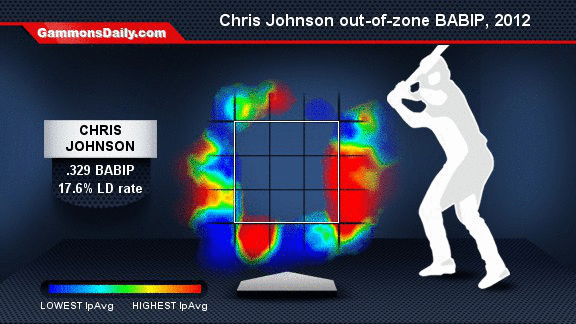Chris Johnson: Junk-Ball Hitter Extraordinaire
 Alec Dopp |
Alec Dopp |  Wednesday, February 5, 2014 at 8:25AM
Wednesday, February 5, 2014 at 8:25AM
Chris Johnson isn't what most would deem a "lethal threat" in the batter's box. With a career slash line of .289/.328/.438, 108 OPS+ and 6.7 offensive wins above replacement over his five years in baseball, the statistical output from the former fourth round selection of the Houston Astros has been more toward that of league average production (.263/.331/.418 since Johnson's 2009 rookie campaign) than anything close to lethal. But last season did shed some light on his most 'lethal' attribute as a hitter: Hitting bad pitches.
While Johnson has maintained a reputation for finding holes in defenses (owning a .361 BABIP since his entrance into the league in 2009), he was exceptional in his respect in 2013, posting a .394 BABIP that ranks as the highest single-season in-play average among qualified batters since 2008 -- second only to Austin Jackson's .396 mark in 2010. But Johnson's insane in-play average mark last season was considerably higher than his .354 mark two seasons ago. As we're about to find out, this increase is confusing for a few reasons.
Two seasons ago, Johnson garnered a .354 BABIP thanks in large part to his 24.4% line drive rate. This LD% was not particularly dominant, mind you, but it did narrowly miss (by 0.4%) the cut to be among the top 10% of all qualified batters that year. Last season, Johnson posted a league-best .394 BABIP, but his line-drive rate actually decreased to 24.3%.
If you can recall past research, no other factor correlates to a player's BABIP better than his line-drive rate. In fact, since 2008, for every 3% increase in line drive rate, a player's BABIP increases by roughly .020 points. Boost your LD% by 6%, and you're looking at a .040 BABIP jump. Considering this, I bet you're wondering: How the hell did Johnson's BABIP rise despite a steady (albeit minimally decreasing) line drive rate? This is where those 'junkball' hitting skills come into play.
Comparing Johnson's out-of-zone BABIP over the last two seasons

Johnson's BABIP on pitches in the strikezone last season was .385, up from .361 in 2012. This again defies logic, as his line-drive on pitches in the zone two years ago was 26.4% compared to 25% last season. But when we shift our focus to pitches out of the zone, we begin to understand his overall BABIP increase. On non-zone pitches last season, Johnson posted a 21.3% line drive rate en route to a .434 out-of-zone BABIP -- second only to Carlos Gomez (.452) among qualified batters. This is a stark increase from 2012, when only 17.6% of Johnson's out-of-zone hits were line drives, giving him a .329 in-play average that was much closer to the .278 league average BABIP on non-zone pitches since 2012.
Call him 'lucky' if you must -- I certainly think luck has at least something to do with it -- but Johnson showed last season that he's getting better at hitting bad pitches, which gives reason to believe his career .361 BABIP mark is sustainable.
Plate discipline be damned.
 Atlanta Braves,
Atlanta Braves,  BABIP,
BABIP,  Chris Johnson
Chris Johnson

